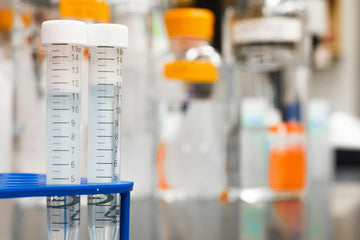Essential amino acids with electrolytes – How they support your performance and recovery
If you train regularly and pursue athletic goals, you already know how crucial proper nutrition is for your training success. In addition to sufficient protein and carbohydrates, you should pay particular attention to two other components: essential amino acids and electrolytes. But why is this combination particularly effective? And what specific benefits does targeted supplementation of these nutrients bring you? You'll find out everything you need to know here.
What are essential amino acids?
Essential amino acids are special protein building blocks that your body cannot produce itself. They must be consumed through your daily diet or through targeted, high-quality nutritional supplements. These amino acids form the basis for many important bodily functions, especially muscle protein synthesis. As is often assumed, amino acids are not only important for athletes, but also contribute to general health.
There are a total of nine essential amino acids:
Leucin
Plays a key role in muscle building and muscle protein synthesis. It supports recovery and prevents muscle loss, especially after intense training.
Isoleucine
Important for energy production in the muscles, promotes regeneration after exertion and improves endurance performance.
Valine
Helps with muscle repair, regulates energy metabolism and reduces fatigue during exercise.
Lysine
Essential for tissue growth and repair, strengthens the immune system and promotes calcium absorption for strong bones.
Methionine
Serves as a sulfur supplier and supports the production of important metabolic compounds. It has antioxidant properties and helps reduce cell damage.
Phenylalanine
Precursor to neurotransmitters such as dopamine and noradrenaline, improves mental alertness, mood and cognitive functions.
Threonine
Promotes collagen formation, strengthens connective tissue and supports liver function and the immune system.
Tryptophan
A precursor to serotonin, it improves sleep quality, mood, and recovery. It also promotes recovery after exertion.
Histidine
Important for tissue growth and repair, supports the formation of red and white blood cells and strengthens the immune system.
The so-called branched-chain amino acids (BCAAs) leucine, isoleucine, and valine are particularly known for their positive effects on muscle building and recovery. Studies clearly show that targeted intake of these amino acids after intense exercise accelerates muscle growth and prevents muscle loss. Furthermore, they replenish your body with all the important minerals lost through sweat after a workout. At MTM , we primarily use amino acids during training to ensure the body is adequately supplied shortly after a heavy set.
The important role of electrolytes
Electrolytes are minerals dissolved in body fluids that perform crucial functions. These include sodium, potassium, magnesium, and calcium. During exercise, you not only lose fluid through sweating, but also large amounts of these electrolytes. A deficiency can lead to muscle cramps, fatigue, reduced performance, and slower recovery. The cause of a cramp in soccer, for example, is almost always a deficiency of electrolytes and minerals.
The most important functions of electrolytes at a glance:
sodium
Regulates fluid balance, muscle contraction and blood pressure.
potassium
Extremely important for muscle function and the maintenance of cell functions.
magnesium
Supports energy metabolism and reduces muscle cramps, but also prevents muscle soreness.
Calcium
Responsible for strong bones and the function of muscles and nerves.
A balanced electrolyte balance is therefore essential for achieving optimal performance during and after exercise and for accelerating recovery. If you'd like to learn more about calcium absorption and processing, we highly recommend this article. There you'll learn everything about D3/K3 and how calcium absorption is regulated by these vitamins.
Why amino acids and electrolytes make sense when combined
The combination of essential amino acids with electrolytes is scientifically sound: While amino acids promote muscle growth and prevent muscle breakdown, electrolytes ensure that all biochemical processes in the body function optimally. This synergistic effect significantly improves recovery after physical exertion. Specifically, this means:
Faster regeneration after intensive training sessions
Less muscle soreness and muscle damage
Improved hydration and stabilization of fluid balance
Increased physical performance in future training sessions
Who benefits most from this combination?
Targeted supplementation of essential amino acids and electrolytes is particularly recommended for people who exercise regularly. Whether strength training, endurance sports, or functional training – an optimized nutrient balance noticeably improves recovery and performance.
Especially people with high sweat loss, intensively training athletes and people who want to expand their performance limits benefit from a regular and balanced supply.
What is the best way to use amino acids and electrolytes?
To maximize the benefits of the combination of amino acids and electrolytes, we recommend taking it immediately after or during intense training sessions. This helps the body quickly replace electrolyte losses and promptly stimulate muscle protein synthesis. For even better recovery, consume a protein shake after training to further promote recovery and muscle building. Here's our recommendation.
Conclusion
The combination of essential amino acids and electrolytes offers an excellent way to effectively support athletic success. By providing a targeted supply of these nutrients, you can shorten recovery times, avoid performance declines, and achieve your athletic goals more efficiently.
Sources:
-
Blomstrand, E., Eliasson, J., Karlsson, HK, & Köhnke, R. (2006).
Branched-chain amino acids activate key enzymes in protein synthesis after physical exercise. The Journal of Nutrition, 136(1 Suppl), 269S-273S. https://doi.org/10.1093/jn/136.1.269S -
Kerksick, CM, Wilborn, CD, Roberts, MD, Smith-Ryan, AE, Kleiner, SM, Jäger, R., ... & Kreider, RB (2018).
ISSN exercise & sports nutrition review update: research & recommendations. Journal of the International Society of Sports Nutrition, 15(1), 1–57. https://doi.org/10.1186/s12970-018-0242-y -
Maughan, R. J., & Shirreffs, S. M. (2008).
Development of individual hydration strategies for athletes. International Journal of Sport Nutrition and Exercise Metabolism, 18(5), 457-472. https://doi.org/10.1123/ijsnem.18.5.457 -
Tipton, KD, & Wolfe, R.R. (2004).
Protein and amino acids for athletes. Journal of Sports Sciences, 22(1), 65-79. https://doi.org/10.1080/0264041031000140554




